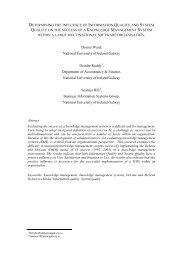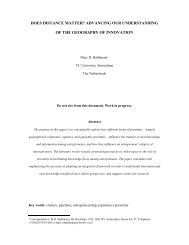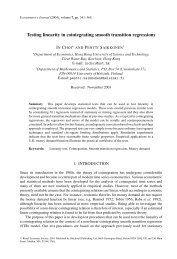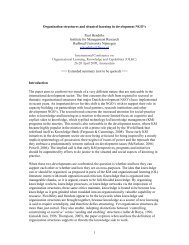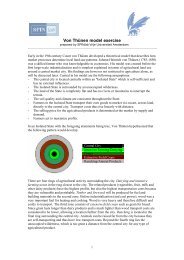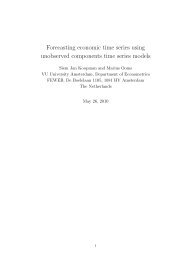The effects of road pricing - Feweb - Vrije Universiteit Amsterdam
The effects of road pricing - Feweb - Vrije Universiteit Amsterdam
The effects of road pricing - Feweb - Vrije Universiteit Amsterdam
Create successful ePaper yourself
Turn your PDF publications into a flip-book with our unique Google optimized e-Paper software.
Travellers have different values <strong>of</strong> time, desired speed, and so on. First-best <strong>pricing</strong><br />
<strong>of</strong>ten makes it necessary to distinguish between different vehicle types and users<br />
(because <strong>of</strong> different marginal costs). It is important to know whether first-best<br />
congestion <strong>pricing</strong> can still be implemented, given these dimensions <strong>of</strong> heterogeneity,<br />
and if not, how second-best tolls are optimally determined. In this context a<br />
distinction is <strong>of</strong>ten made between anonymous tolling schemes (independent <strong>of</strong> vehicle<br />
type and driver) and non-anonymous (type-specific) tolls.<br />
Many studies have been conducted on the implications <strong>of</strong> the problem <strong>of</strong><br />
heterogeneity and <strong>pricing</strong>. <strong>The</strong> topics range from heterogeneity in drivers’ values <strong>of</strong><br />
time and trip-timing preferences to the heterogeneity in travel speed. Another example<br />
<strong>of</strong> a study that is <strong>of</strong> interest here is that <strong>of</strong> Verhoef and Small (2004), who consider a<br />
differentiation <strong>of</strong> tolls across parallel traffic lanes by using a static model. <strong>The</strong>y show<br />
that an anonymous toll may still be optimal on each lane separately, and efficient<br />
segregation <strong>of</strong> drivers is achieved without regulation. It should be noted that the extra<br />
gains are rather small, so that a second-best single toll applied to the entire highway<br />
does not impose much <strong>of</strong> a welfare loss. Optimal anonymous tolling may entail<br />
segregation <strong>of</strong> vehicle or driver types onto separate routes.<br />
Interactions with other sectors<br />
Imperfections in other sectors <strong>of</strong> the economy have consequences for second-best<br />
optimal <strong>pricing</strong> <strong>of</strong> transport services. Modelling the transport sector typically assumes<br />
that the rest <strong>of</strong> the economy operates under first-best conditions. Although applied<br />
with the aim <strong>of</strong> simplifying the modelling exercise, it is not very realistic. For<br />
example, the existence <strong>of</strong> distortionary taxes on other markets (especially the labour<br />
market) and income distribution (which might be suboptimal) can be motivated by<br />
governmental objectives but have implications for <strong>pricing</strong> in transport. Intersectoral<br />
issues matter because transport <strong>pricing</strong> interacts with other markets that may be<br />
strongly distorted.<br />
<strong>The</strong> existing literature on intersectoral issues shows their importance for optimal<br />
<strong>pricing</strong>: they are almost always relevant (MC-ICAM, 2002). <strong>The</strong> most relevant<br />
relation is with the labour market, which is heavily distorted: labour taxes exist<br />
mainly because the government needs revenues and for equity reasons, but strongly<br />
distort the labour-leisure choice. This implies that, whenever there is a reform in<br />
transport prices, the effect on the labour market distortion should be taken into<br />
account. Moreover, since distributional objectives can hardly be achieved by using<br />
distortionary labour taxes alone, the distributional concern will almost always be<br />
relevant in transport <strong>pricing</strong>.<br />
In this context, the spending <strong>of</strong> revenues from <strong>pricing</strong> schemes is also important for<br />
the overall success <strong>of</strong> the measure. <strong>The</strong>se revenues might be used to subsidise public<br />
transport, but also to reduce labour taxes, to increase government spending on other<br />
services, and so on. <strong>The</strong> <strong>effects</strong> for other sectors should not be neglected when<br />
looking at the <strong>effects</strong> <strong>of</strong> <strong>pricing</strong>. Parry and Bento (1999), for instance, show that the<br />
general equilibrium <strong>effects</strong> <strong>of</strong> <strong>road</strong> <strong>pricing</strong> schemes are sensitive to the spending <strong>of</strong><br />
revenues, and may deviate considerably from partial equilibrium outcomes. This may<br />
have important implications for gaining social acceptance for congestion <strong>pricing</strong><br />
schemes.<br />
2.6 Conclusions<br />
This chapter has aimed to give an overview <strong>of</strong> the economics <strong>of</strong> transport <strong>pricing</strong> and<br />
provide a basic understanding <strong>of</strong> the fundamental issues in transport <strong>pricing</strong>. It<br />
28





